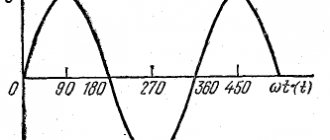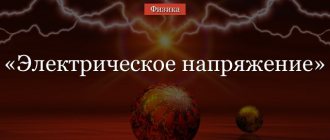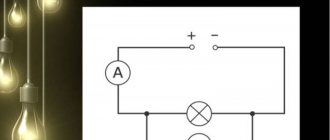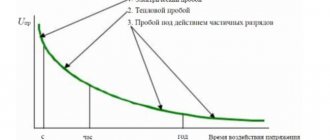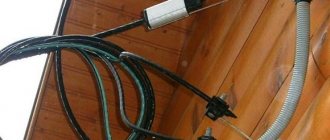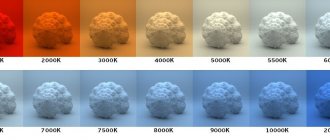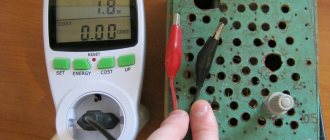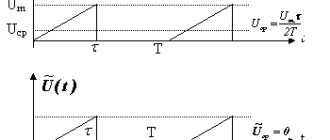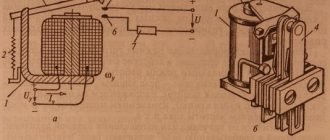Electrical parameters are studied as part of school programs. After exams, scientific definitions and formulas are quickly forgotten. Meanwhile, basic knowledge in the relevant field is needed not only by specialists and radio amateurs. They will be useful to ordinary users for connecting household appliances and solving other practical problems. This publication explains what a unit of current is.
Classic definition of current strength
About electric current
To facilitate understanding of the topic, you can use analogues (comparisons) from the outside world. Electrical quantities are sometimes explained using the example of a conventional pipeline:
- the flow of electrons is similar to the movement of a liquid;
- voltage (potential difference) – different pressure levels;
- as the cross-section of the conductor decreases, the current resistance increases - in the same way, the pressure has to be increased to move more water per unit of time.
Through the transparent walls you can observe the movement of the liquid flow. The presence of visual markers—contaminants—will simplify the visual experiment. However, the most keen-sighted person is not able to see the movement of microscopically small electrons.
However, it is the movement of a stream of charged particles that is an electric current. Why does such an action, even after a long period of experiment, not change the mass (size) of individual sections of the conductor?
As in the case of observation, the answer to the question is explained by the very small magnitude of the parameters under consideration. Electrons can be compared to ants. When moving to another “house”, the old anthill retains its size (shape). Likewise, the mass of the conductor will not change noticeably even if particles with electrical charges are completely removed from it.
Impact principle
The properties of EP are most often constant and uniform. The planet has its own protective background, which has practically no effect on living organisms. Minor manifestations become noticeable to humans only during a severe thunderstorm. In such a situation, it may even seem that the air is trembling with tension. But for most people this does not pose any threat.
The technology industry does not stand still, thanks to which specialists are producing more and more different units, each of which is capable of generating its own electric shock. The indicator significantly exceeds the natural background, which is 0.5 kV/m. Of course, this feature did not go unnoticed by experts. As a result of numerous tests, they derived the maximum permissible voltage, which does not create restrictions for humans. Its size is 27 kV/m.
Even if you turn on all household devices at once, the maximum value will not be exceeded. An adult can receive a small percentage of negative effects only when spending a long time near high-voltage wires. In such an environment, the tension is very high, which is why standing for a long time or working in such an area is strictly prohibited. Specialists who, due to work circumstances, are forced to be surrounded by such electronic devices must have time to complete all work in a maximum of one and a half hours.
What is the unit of current?
Capacitor Capacitance: Unit of Measurement
Below are the main parameters of a typical electrical circuit (standard symbols for formulas and abbreviated names are given in parentheses):
- units of current (I) – Amperes (A);
- voltage (U) – Volts (V);
- resistance (R) – Ohms (Ohm).
To complete the study, it is necessary to remember the quantitative indicator, power (W). It is measured in Watts (W).
If we continue the analogy with water, we can draw several important intermediate conclusions. To pass more liquid (electrons), the diameter of the pipe (conductor) is increased. This solution is accompanied by an increase in current. Voltage is measured by the potential difference between two points in a circuit. To increase it, the charge ratio is changed as needed.
Resistance prevents the passage of electrons. This process is accompanied by the conversion of electrical energy into thermal energy. In some devices, this feature performs useful functions.
The heating element in the boiler has a high resistance (R)
Power consumption can be compared to the amount of water that flows through a certain section of the transport system per unit of time.
Coulomb's law
In this case, the force characteristic of the electric field works for a point charge located at a distance of a certain radius from it. If we take this indicator according to the standard modulus, then the result is a Coulomb field.
You might be interested in this: How to make a simple voltage regulator with your own hands
The direction of the vector directly depends on the existing sign of the charge . If it is positive, then the EP will “move” along the radius. Otherwise, the vector itself will be directed towards the charge.
To understand the key features of the law, you can study the main drawings and diagrams that show lines of force. In textbooks, the main characteristics of EP are explained rather difficultly. If you use specialized literature to study this topic, then you need to take into account that when constructing drawings of power lines, their final density is proportional to the modulus of the tension vector. This is a kind of hint from experts that can help during an exam or just to check your knowledge.
Ampere – SI unit of current measurement
Voltage unit
According to the most popular international standard (SI) for direct current, one ampere (1A) corresponds to the passage of a unit charge (1 coulomb) in 1 s:
1A = 1K/1 s.
Another basic definition is created with the additional use of mechanical components. In accordance with it, a similar current creates an interaction force of 2 * 10-7 Newtons for each linear meter of a structure consisting of two parallel conductors. This means placing such a device in a neutral environment (vacuum), completely isolated from external electromagnetic radiation.
Short description
It is impossible to see the electric field (EF) with the naked eye: it can be detected in the process of influencing charged bodies. Surprisingly, there may not be a direct contact, since the force nature must be present. After all, everyone knows that electrified hair will be attracted to other objects. Numerous studies have been able to prove that gravitational fields have a similar operating principle. This phenomenon was first described in Coulomb's law.
The standard formula for the electric field looks like this: F = d₁ d₂ / 4 π q q₀ r².
Explanation:
- d₁ and d₂ are discharge parameters in coulombs.
- q ₀ - this symbol can only denote the electrical constant.
- q is the dielectric constant.
- F is the force of interaction between different charges (can be measured in newtons).
- r is the distance between the two objects in question in meters.
Thanks to the formula for the strength of the electrostatic field, you can determine the fact that the further you are from the center, the less its effect will be felt. Graphically it can be depicted in the form of lines of force. Their final location directly depends on the geometric parameters of the media.
Today, experts have learned to identify several types of fields:
- Specific heterogeneous. The field around a spherical or point charge is considered. All field lines diverge only if this parameter has a positive value.
- Homogeneous field. All lines of force are located exclusively parallel to each other. Experts say that the ideal option is when the charged plates are infinite.
Lines of force induced by an electric charge are of the closed type. A different situation is observed only for a vortex field formed around a changing magnetic flux.
Formulas for calculating current characteristics
Lumen is a unit of measurement of luminous flux
If a direct current source is connected to the conductor, the basic parameters can be calculated using the classical formula. Current in amperes is equal to voltage in volts divided by electrical resistance in ohms:
I = U/R.
The power dependence is displayed as follows:
I = P/U = √P/R.
A simple transformation can be used to calculate other quantities:
- R=U/I=U2/P=P/I2;
- U= √P*R=I*R=P/U;
- P=I2*R=U2/I=U*I.
Graphic representation of basic formulas
For your information. In AC circuits, the sinusoidal waveform is taken into account. Resistive loads (capacitors, coils) create a phase shift between voltage and current.
Magnetic quantities
Magnetism is closely related to electricity, since both are manifestations of a single fundamental physical process - electromagnetism. Therefore, an equally close connection is characteristic of methods and means of measuring electrical and magnetic quantities. But there are also nuances. As a rule, when determining the latter, an electrical measurement is practically carried out. The magnetic quantity is obtained indirectly from the functional relationship connecting it with the electrical one.
The reference quantities in this measurement area are magnetic induction, field strength and magnetic flux. They can be converted using the measuring coil of the device into EMF, which is measured, after which the required values are calculated.
- Magnetic flux is measured using instruments such as webermeters (photovoltaic, magnetoelectric, analog electronic and digital) and highly sensitive ballistic galvanometers.
- Induction and magnetic field strength are measured using teslameters equipped with various types of transducers.
The measurement of electrical and magnetic quantities, which are directly related, allows us to solve many scientific and technical problems, for example, the study of the atomic nucleus and the magnetic field of the Sun, Earth and planets, the study of the magnetic properties of various materials, quality control and others.
Effect of current on different materials
The same current has different effects when passing through different materials. Metals, for example, have good conductivity. Impurities increase resistance, so to improve economic performance, power lines are made from well-purified copper. Polymer compounds are dielectrics and are often used to create insulation.
Water conducts electricity due to the ions it contains. This property is used for filtration, creating thin coatings and autonomous power supplies. It is enough to lower plates with opposite charges into the liquid to ensure the movement of particles in opposite directions.
A weak electric current stimulates brain activity and has a stimulating effect on the skin. Specialized devices are used in medical institutions and beauty salons. High current is dangerous to humans, so appropriate protective equipment should be used when working with electricity.
Exploring the potential
It is this parameter that is considered a common characteristic of EP. Potential acts as stored valuable energy used to move various charges. As a result, the potential may be completely used up, causing its indicator to be zero.
The accumulation process occurs in reverse order. As a striking example, we can use the same charge, but located outside the electron beam. Only when a certain force moves it inward and gradually moves it there does the necessary potential appear.
If a person has just encountered this industry and wants to understand it, then it is better for him to imagine an ordinary spring. In a calm state, it lacks any potential, which is why it can only be regarded as a small metal object. But as soon as a person begins to gradually squeeze it, a potential will be formed. If you quickly release the spring, it will instantly straighten and at the same time move all foreign objects out of its path.
You might be interested in the principle of operation, purpose and scope of application of triggers
This example clearly demonstrates that the potential level will always correspond to the applied effort to move the charge. In modern science, this indicator can be measured in volts.
Non-electrical quantities
The convenience of electrical methods makes it possible to successfully extend them to measurements of all kinds of physical quantities of a non-electrical nature, such as temperature, dimensions (linear and angular), deformation and many others, as well as to study chemical processes and the composition of substances.
Devices for electrical measurement of non-electrical quantities are usually a complex of a sensor - a converter into some circuit parameter (voltage, resistance) and an electrical measuring device. There are many types of transducers, thanks to which you can measure a wide variety of quantities. Here are just a few examples:
- Rheostat sensors. In such converters, when exposed to the measured value (for example, when the level of a liquid or its volume changes), the rheostat slider moves, thereby changing the resistance.
- Thermistors. The resistance of the sensor in devices of this type changes under the influence of temperature. They are used to measure gas flow velocity, temperature, and to determine the composition of gas mixtures.
- Strain resistances make it possible to measure wire deformation.
- Photosensors that convert changes in illumination, temperature, or movement into a photocurrent that is then measured.
- Capacitive transducers used as sensors for the chemical composition of air, movement, humidity, pressure.
- Piezoelectric transducers operate on the principle of the occurrence of EMF in some crystalline materials under mechanical influence on them.
- Induction sensors are based on converting quantities such as speed or acceleration into an induced emf.
Development of electrical measuring instruments and methods
The wide variety of means for measuring electrical quantities is due to many different phenomena in which these parameters play a significant role. Electrical processes and phenomena have an extremely wide range of use in all industries - it is impossible to specify an area of human activity where they would not find application. This determines the ever-expanding range of problems of electrical measurements of physical quantities. The variety and improvement of means and methods for solving these problems is constantly growing. The area of measurement technology such as measuring non-electrical quantities using electrical methods is developing especially quickly and successfully.
Modern electrical measuring technology is developing in the direction of increasing accuracy, noise immunity and speed, as well as increasing automation of the measuring process and processing of its results. Measuring instruments have evolved from the simplest electromechanical devices to electronic and digital devices, and then to the latest measuring and computing systems using microprocessor technology. At the same time, the increasing role of the software component of measuring devices is obviously the main development trend.
